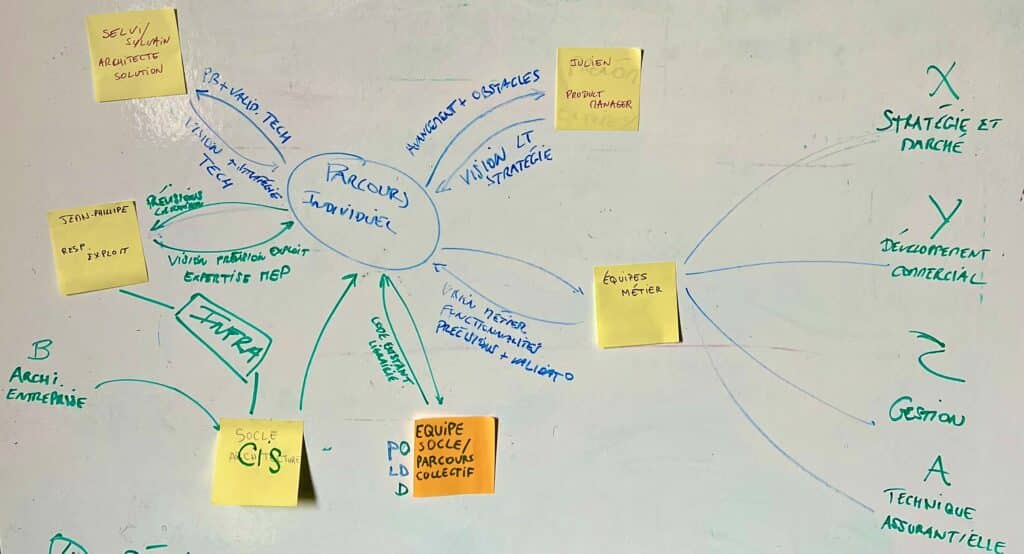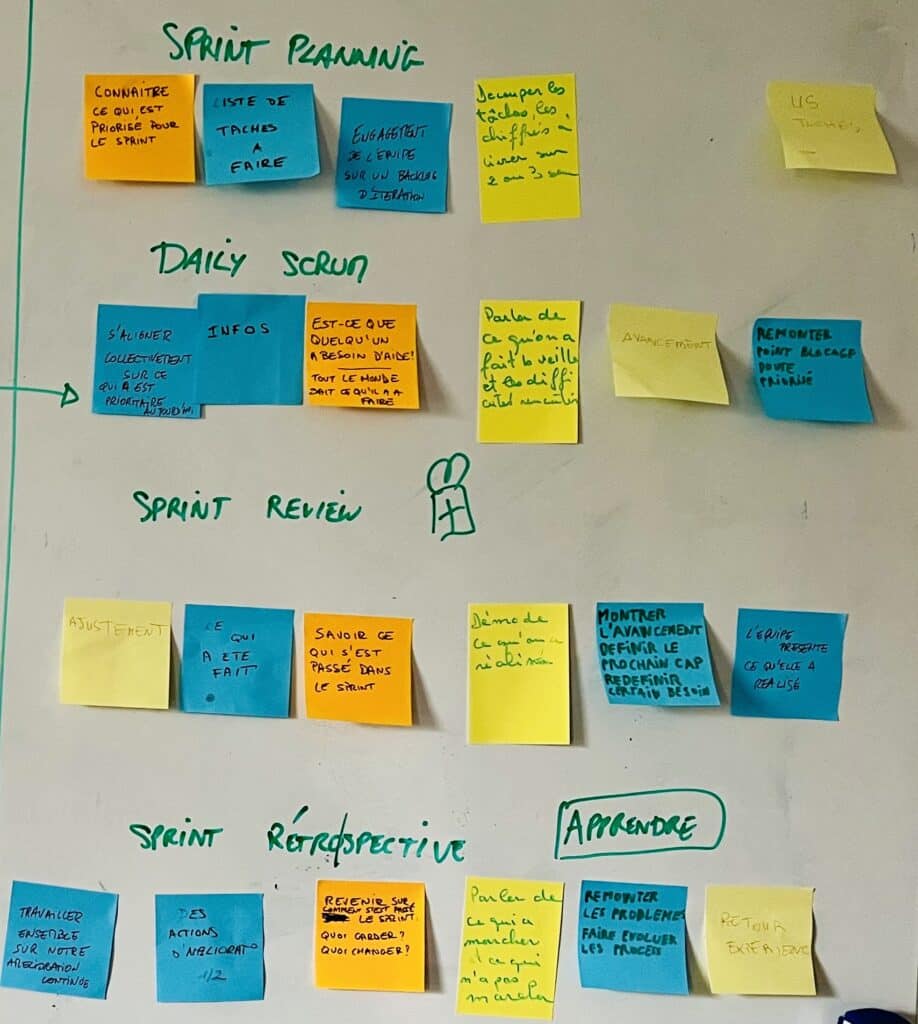
An exercise that I find decisive and yet so often forgotten in the start-up of a team is the determination of the framework of interactions. By this I mean this conversation allowing everyone to better understand the other beyond their role and to build together the new face of the team by combining their colors.
Using a Team Canvas as a conversation medium could have been a good base, but I decided to do otherwise. This is what I describe to you in this article!
Good reading ! 😉
Context

The initial request came from the team facilitator who wanted to be able to participate in the content rather than the framework. I found it rather relevant in the sense that it was a good time to get to know each other and create a bond.
Indeed, this team is brand new with people working for a few weeks in other teams to work on the subjects and others who have just arrived.
Reminder: A few days before the intervention, I learn that the PO is on shutdown and therefore will not be able to participate.
Design

The information about the non-presence of the OP is crucial for my design.
Indeed, a sentence that I keep from my training in Team Coaching is the following:
“It's not the team that creates the goal, it's the goal that creates the team”.
– Global Team Coaching Institute
The initial term being “purpose” in English for more details.
Starting a team then seems particularly complicated to me if we don't talk about the content or the objectives to be achieved. So we decided to call on the Product Manager for an hour to give the main directions while waiting for the return of the PO. It will therefore be necessary to adapt to its provisions so that it remains coherent in the process.
animation frame
Here is the information we are going with:
| 1 main intention | create team dynamics to start in the best conditions |
| 1 secondary intention | get to know them and build the relationship |
| 2 times 2 hours of time | 2 hours in the morning from 10 a.m. to 12 p.m. and 2 hours in the afternoon from 2 p.m. to 4 p.m. |
| 5 people | Lead dev, BA, 3 devs, Facilitator |
| 1 constraint | PM available from 2:30 p.m. to 3:30 p.m. |
To build, I start by defining the objectives to be achieved before deciding how.
| Goals | Description |
|---|---|
| 1 | I would like them to be able to learn to discover themselves beyond their role in the team, and this, quickly. |
| 2 | I would like the team to have a vision of their goals (even before the PM intervenes) |
| 3 | I would like the team to be aware of its ecosystem |
| 4 | I would like the team to define some rules of interaction |
| 5 | I would like the team to agree on a common understanding of an Agile / Scrum mode of operation. |
I would therefore have 5 distinct phases through which to pass, arranged in order of importance. Indeed, given the time constraints, I want to make sure that the maximum value will be achieved at the start, even if it means postponing the other phases later. They can be led by the facilitator if necessary.
Let us then see the possible paths of unfolding.
| Phase | Objective | Unrolled |
|---|---|---|
| 1 | Discover yourself beyond your role | When I'm talking about discovering yourself beyond your role, it's simply knowing the people for whom they are before seeing only the title and the function they represent. Having a number of phases, I'm going to come up with something simple and quick to start with. Everyone will introduce themselves, on post-it notes, with their First name, her Function / its Role, and an characteristic individual. This last element will aim to create more sensitivity to the other, from the start. |
| 2 | Have a shared vision of goals | In this part, I'm just going to ask them the question. These are the results that will be interesting to discuss. |
| 3 | Become aware of your ecosystem | Here we will make a Stakeholder Mapping in order to visualize the stakeholders and the relationships that will operate with the team |
| 4 | Define some interaction rules | In this part, I will mainly evoke the notion of "psychological safety" as I was able to do in This article. However, given the time available, I simply think to stay on the first phase around the personal need. |
| 5 | Sharing a common Agile / Scrum operation | The idea here is to talk a little bit about Agile but above all to focus on the Scrum events that will punctuate the life of the team. The exchanges will be rather around the objectives of each event than on the proceedings. Indeed, it will be the role of the facilitator to manage the rest 🙂 |
We are ready to launch the animation. Let's see together what happened 🙂
Animation

Phase 1: getting to know each other beyond our role
As planned, I ask everyone to note on a post-it their first name, their function / role and an individual characteristic. I titled this last element: "what you need to know about me", implied "so that it goes well" 😛
When each person has finished, I invite them one by one to stick their post-it notes and give the group a few details. Here are the results below:

When it seemed interesting to me, I took the liberty of questioning the person a little longer. This has the advantage of generating more exchanges and interaction between the participants. Unsurprisingly, it is on the characteristic that I relied 😉
Some examples :
| Characteristic | Complementary questions | For what ? |
|---|---|---|
| I like to help | – What do you enjoy about helping others? – What happens if your help is refused? – Do you expect this from others as well? | Giving meaning to others on the importance of this characteristic for the person, through introspection Explain behaviors expected and their impacts |
| Fan of Japan (Manga, Anime…) | – Have you ever been there? – What are the last Mangas / Animes that you saw? – Do you have a recommendation? | Create link, connections. A person who talks about what he likes helps to develop a climate of sharing and openness. |
| I like the dev well done | – What do you mean by “well done”? – When it is not “well done”, what happens? – By wanting to do too well, do you sometimes forget the time constraints? | Explain the needs Become aware of the limits and bring them to the attention of the team |
| I like sharing | – On what topics do you like to share? – How important is it to you? – How do you like to share? | Paving the way for the collaborative and the collective |
Note: the start of a meeting can be a little silent or even shy, intervening in this way allows you to give a little more colors to conversations. People then open up more easily if the right environment is created. Having the mandate on the framework, I can more easily afford it and it allows me to create this atmosphere of curiosity and non-judgment that I particularly like! 🙂
Phase 2: Team Goals
In this second phase, I again question the participants:
What are your team's goals? Think carefully about the impacts you want to generate and therefore for whom 🙂
Here are the answers that were given:

Without going into the details of each one, it always seems interesting to me to see the diversity of answers in relation to the same question. This often depends on the positioning of each person in relation to their role, their profession and their perceived contribution to achieving the objective.
The heart of the exercise is therefore in the trade facilitation. The idea here is to clarify the final expectation and the impacts of the realization of the given project with a first vision of the users.
Note: The PM was to provide more details later but I already wanted to gauge where the team was on the subject.
This then naturally leads to phase 3 where we will seek to clarify the ecosystem allowing the team to achieve its objectives.
Phase 3: Stakeholder Mapping
In this part, we will make a Stakeholder Mapping. The general idea is to model the different stakeholders as well as their interactions in terms of information flow.
We therefore build it together as we go along to finally arrive at the following result:

It was a good opportunity to (re)present the organization to the team members, especially the new ones. Many questions have emerged and have made the cartography evolve over time. It's a good sign, the team is already working together to clarify things!
Phase 4: Some interaction rules
In this phase, I wanted to address the notion of psychological safety which, in the end, seems to me to be too little known to the teams. This was indeed the case for this team.
After having quickly defined what psychological safety was, I invited everyone to reflect on their needs in order to feel safe and be able to express themselves freely within the collective. Each is then passed gradually in the same way as for phase 1.

It is interesting to see that after all the previous phases have contributed to creating a friendly and open atmosphere. This greatly helped everyone to be able to express their share of vulnerability in a serene way.
Note: I didn't need to question that much this time, the team members doing it more naturally themselves. I especially asked for clarification when the same terms were used to fully understand what was meant behind 🙂
In terms of timing, we managed to complete this phase before lunch. This is to say that the instructions being simple and clear, it can go quite quickly while being rich in conversations.
Interlude: PM Sharing
Back from lunch, the PM being available a little earlier, we took the opportunity to share the vision of the project. He was able to get to know the team better and answer their questions.
We then continue with our last phase 🙂
Stage 5.1: Agile
In this last phase, I wanted to make a quick pass on Agility. Here are the few messages that I have chosen to convey.
Agile ≠ Scrum
For this I simply use the Golden Circle by Simon Sinek applied to the subject of Agility. Indeed, I appreciate the visual side of this representation which easily allows to open the exchanges.

I therefore mention the Agile Manifesto and its description of 4 values and 12 fundamental principles.
Speaking of values, I share the summary thatAlistair Cockburn had done a few years ago during a Scrum Day (oh yes it's dated!):
People over Process
The message here is that Agility is not just a set of practices, but is intended to help people interact better together to achieve their goals.
Moreover, before going into the practices, I wanted to make a passage on 1 of the 12 principles:
Working software is the main measure of progress
I particularly appreciate this principle because it questions several notable subjects: what do we mean by operational and progress measurement ?
Operational means functional and responding to customer needs
This therefore implies 2 levels of feedback:
- Of the'crew to make sure the solution is working properly
- Of customer to make sure we are meeting their needs
This is why we try to build small pieces of solutions that are understandable by the customer. He will be able to tell us if this corresponds to his need. This team-client relationship is therefore essential to maintain to ensure that we are going in the right direction. It's what we put behind progress measurement.
Stop Starting, Start Finishing
In fact, we consider that we have made progress if we have been able to provide a usable item of value by the customer. Having something “in progress” has no value in itself. This is why we first seek to to end what we are committed to rather than start new elements.
Stage 5.2: Scrum Events
After introducing some key Agile messages, we got down to discussing the 4 Scrum events: Sprint Planning, Daily Scrum, Sprint Review and Sprint Retrospective.
I invited each person to note on post-it the objective(s) of each event. One post-it per event of course.
We could also have simply presented the events in a top-down manner. It's true. However, what interested me here was not to share the theory but rather for the group to co-create the meaning of these elements together. Social Constructionism when you hold us 🙂
Indeed, it is rare today that people have not heard at all about Scrum events in the IT world. On the other hand, they do not always have the same intention or implementation.
Here are the results :

We can again see the difference in the responses of the participants:
- Some respond with a process: Talk about what we did the day before and the difficulties encountered“, “ Talk about what worked and what didn't', 'Cut the tasks, quantify them and deliver them over 2 or 3 weeks"
- Others by deliverables: “ Info“, “ Improvement actions“, “ To-do list"
It is in this case that I refocus the exchanges on the objectives of the different events. The heart of my action is therefore in facilitation rather than in training or coaching. The idea is again that they leave with a common base on which to start, even if it means changing it over time.
However, it seemed important to me to open the door to other perspectives for people who only had a “practical” understanding of Scrum.
In terms of timing, we finish just in time to go have a coffee together 🙂
Conclusion

In this animation, I opted for simplicity by focusing mainly on the interactions of team members with each other. Indeed, it is not always necessary to build a complicated workshop to obtain a result. A clear intention, a few questions, facilitation and support to structure the exchanges may be enough 🙂






